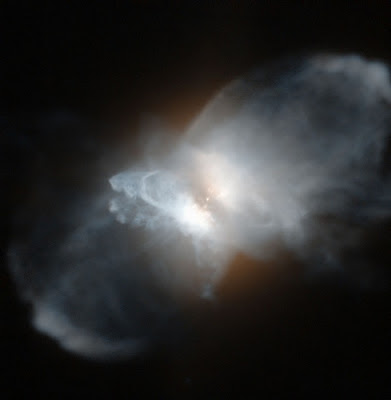
The Frosty Leo Nebula
The underlying state of the universe is timeless. Before the first nanosecond of the Big Bang, there was only the potential for time in a dimension of all possibilities, after which quantum objects (energy, spin, charge, gravity), emerged. A potential doesn’t have a life span. It encompasses past, present, and future. The ground state of physics turns out to resemble the zero state of samadhi.
Once these timeless possibilities begin to collapse into space-time events, our connection to eternity seems lost. That is an illusion, though, fostered by our dependence on clock time. You have always been eternal; you still are. - Deepak Chopra in "War of the Worldviews: Science Vs. Spirituality"
Three thousand light-years from Earth lies the strange protoplanetary nebula IRAS 09371+1212, nicknamed the Frosty Leo Nebula. Despite their name, protoplanetary nebulae have nothing to do with planets: they are formed from material shed from their aging central star. The Frosty Leo Nebula has acquired its curious name as it has been found to be rich in water in the form of ice grains, and because it lies in the constellation of Leo.
This nebula is particularly noteworthy because it has formed far from the galactic plane, away from interstellar clouds that may block our view. The intricate shape comprises a spherical halo, a disc around the central star, lobes and gigantic loops. This complex structure strongly suggests that the formation processes are complex and it has been suggested that there could be a second star, currently unseen, contributing to the shaping of the nebula.
Protoplanetary nebulae like the Frosty Leo Nebula have brief lifespans by astronomical standards and are precursors to the planetary nebula phase, in which radiation from the star will make the nebula’s gas light up brightly. Their rarity makes studying them a priority for astronomers who seek to understand better the evolution of stars.
This nebula is particularly noteworthy because it has formed far from the galactic plane, away from interstellar clouds that may block our view. The intricate shape comprises a spherical halo, a disc around the central star, lobes and gigantic loops. This complex structure strongly suggests that the formation processes are complex and it has been suggested that there could be a second star, currently unseen, contributing to the shaping of the nebula.
Protoplanetary nebulae like the Frosty Leo Nebula have brief lifespans by astronomical standards and are precursors to the planetary nebula phase, in which radiation from the star will make the nebula’s gas light up brightly. Their rarity makes studying them a priority for astronomers who seek to understand better the evolution of stars.